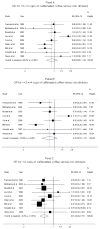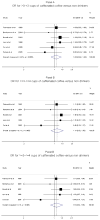Coffee and tea intake and risk of head and neck cancer: pooled analysis in the international head and neck cancer epidemiology consortium
- PMID: 20570908
- PMCID: PMC3047460
- DOI: 10.1158/1055-9965.EPI-10-0191
Coffee and tea intake and risk of head and neck cancer: pooled analysis in the international head and neck cancer epidemiology consortium
Abstract
Background: Only a few studies have explored the relation between coffee and tea intake and head and neck cancers, with inconsistent results.
Methods: We pooled individual-level data from nine case-control studies of head and neck cancers, including 5,139 cases and 9,028 controls. Logistic regression was used to estimate odds ratios (OR) and 95% confidence intervals (95% CI), adjusting for potential confounders.
Results: Caffeinated coffee intake was inversely related with the risk of cancer of the oral cavity and pharynx: the ORs were 0.96 (95% CI, 0.94-0.98) for an increment of 1 cup per day and 0.61 (95% CI, 0.47-0.80) in drinkers of >4 cups per day versus nondrinkers. This latter estimate was consistent for different anatomic sites (OR, 0.46; 95% CI, 0.30-0.71 for oral cavity; OR, 0.58; 95% CI, 0.41-0.82 for oropharynx/hypopharynx; and OR, 0.61; 95% CI, 0.37-1.01 for oral cavity/pharynx not otherwise specified) and across strata of selected covariates. No association of caffeinated coffee drinking was found with laryngeal cancer (OR, 0.96; 95% CI, 0.64-1.45 in drinkers of >4 cups per day versus nondrinkers). Data on decaffeinated coffee were too sparse for detailed analysis, but indicated no increased risk. Tea intake was not associated with head and neck cancer risk (OR, 0.99; 95% CI, 0.89-1.11 for drinkers versus nondrinkers).
Conclusions: This pooled analysis of case-control studies supports the hypothesis of an inverse association between caffeinated coffee drinking and risk of cancer of the oral cavity and pharynx.
Impact: Given widespread use of coffee and the relatively high incidence and low survival of head and neck cancers, the observed inverse association may have appreciable public health relevance.
Figures


Comment in
-
Tea, coffee and oral cancer risk.Evid Based Dent. 2011;12(1):23-4. doi: 10.1038/sj.ebd.6400780. Evid Based Dent. 2011. PMID: 21436863
Similar articles
-
Coffee and tea consumption and the risk of head and neck cancer: An updated pooled analysis in the International Head and Neck Cancer Epidemiology Consortium.Cancer. 2025 Jan 15;131(2):e35620. doi: 10.1002/cncr.35620. Epub 2024 Dec 23. Cancer. 2025. PMID: 39711146 Free PMC article.
-
Coffee and tea intake and risk of oral, pharyngeal and esophageal cancer.Oral Oncol. 2003 Oct;39(7):695-700. doi: 10.1016/s1368-8375(03)00081-2. Oral Oncol. 2003. PMID: 12907209
-
Coffee, tea, and fatal oral/pharyngeal cancer in a large prospective US cohort.Am J Epidemiol. 2013 Jan 1;177(1):50-8. doi: 10.1093/aje/kws222. Epub 2012 Dec 9. Am J Epidemiol. 2013. PMID: 23230042
-
Tea, coffee, and caffeinated beverage consumption and risk of epithelial ovarian cancers.Cancer Epidemiol. 2016 Dec;45:119-125. doi: 10.1016/j.canep.2016.10.010. Epub 2016 Oct 27. Cancer Epidemiol. 2016. PMID: 27810483 Clinical Trial.
-
Coffee consumption and the risk of lung cancer: an updated meta-analysis of epidemiological studies.Eur J Clin Nutr. 2016 Feb;70(2):199-206. doi: 10.1038/ejcn.2015.96. Epub 2015 Jun 17. Eur J Clin Nutr. 2016. PMID: 26081490 Review.
Cited by
-
Risk Prediction Models for Head and Neck Cancer in the US Population From the INHANCE Consortium.Am J Epidemiol. 2020 Apr 2;189(4):330-342. doi: 10.1093/aje/kwz259. Am J Epidemiol. 2020. PMID: 31781743 Free PMC article.
-
Dietary Heat-Treatment Contaminants Exposure and Cancer: A Case Study from Turkey.Foods. 2023 Jun 9;12(12):2320. doi: 10.3390/foods12122320. Foods. 2023. PMID: 37372531 Free PMC article.
-
Lessons learned from the INHANCE consortium: An overview of recent results on head and neck cancer.Oral Dis. 2021 Jan;27(1):73-93. doi: 10.1111/odi.13502. Epub 2020 Jul 16. Oral Dis. 2021. PMID: 32569410 Free PMC article. Review.
-
Tea consumption is associated with decreased risk of oral cancer: A comprehensive and dose-response meta-analysis based on 14 case-control studies (MOOSE compliant).Medicine (Baltimore). 2018 Dec;97(51):e13611. doi: 10.1097/MD.0000000000013611. Medicine (Baltimore). 2018. PMID: 30572470 Free PMC article.
-
Tea consumption and risk of head and neck cancer.PLoS One. 2014 May 5;9(5):e96507. doi: 10.1371/journal.pone.0096507. eCollection 2014. PLoS One. 2014. PMID: 24796481 Free PMC article.
References
-
- Blot WJ, McLaughlin JK, Winn DM, et al. Smoking and drinking in relation to oral and pharyngeal cancer. Cancer Research. 1988;48:3282. - PubMed
-
- Negri E, La Vecchia C, Franceschi S, Tavani A. Attributable risk for oral cancer in northern Italy. Cancer Epidemiol Biomarkers Prev. 1993;2:189–93. - PubMed
-
- Goldenberg D. Maté: a risk factor for oral and oropharyngeal cancer. Oral Oncology. 2002;38:646–9. - PubMed
-
- Mayne ST, Morse DE, Winn DM, editors. Cancer epidemiology and prevention. New York: Oxford Press; 2006. Cancers of the oral cavity and pharynx.
Publication types
MeSH terms
Substances
Grants and funding
- P50CA90388/CA/NCI NIH HHS/United States
- R01 DA011386/DA/NIDA NIH HHS/United States
- R01 CA078609/CA/NCI NIH HHS/United States
- R21ES011667/ES/NIEHS NIH HHS/United States
- R03CA113157/CA/NCI NIH HHS/United States
- R01CA51845/CA/NCI NIH HHS/United States
- CA100679/CA/NCI NIH HHS/United States
- R01 CA100679/CA/NCI NIH HHS/United States
- R03 CA113157/CA/NCI NIH HHS/United States
- R03CA77954/CA/NCI NIH HHS/United States
- R01DA11386/DA/NIDA NIH HHS/United States
- T32CA09142/CA/NCI NIH HHS/United States
- T32 CA009142/CA/NCI NIH HHS/United States
- U01 CA096134/CA/NCI NIH HHS/United States
- U01CA96134/CA/NCI NIH HHS/United States
- ImNIH/Intramural NIH HHS/United States
- R03 CA077954/CA/NCI NIH HHS/United States
- R21 ES011667/ES/NIEHS NIH HHS/United States
- CA78609/CA/NCI NIH HHS/United States
- P50 CA090388/CA/NCI NIH HHS/United States
LinkOut - more resources
Full Text Sources
Medical

